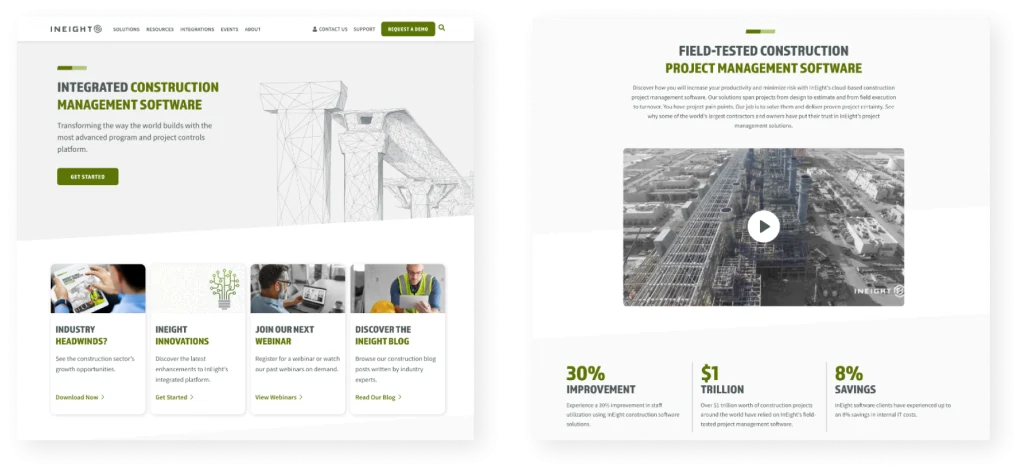In this post, we guide you through different factors to consider when developing your B2B website strategy and helpful tips to get you started.
You’ve determined that your B2B website is in need of a redesign. Now what?
Before you can begin dreaming up beautiful designs that will modernize your company’s image or even map out your main menu structure, you’ll need to spend some time creating a website strategy for your business.
An effective website strategy goes beyond color palettes and organization to serve your key business functions. After all, the point of a website is not only to increase visibility, but ultimately to convert visitors into buyers.
Here, we’ve put together a guide for creating and implementing a B2B website strategy that will capture leads, build credibility and drive sales.
B2B Website Strategy: Factors to Consider
When redesigning a website, a critical first step is to think about how the redesign will serve your business as a whole. The best websites are the ones that prioritize business goals and the needs of customers.
In general, your website should:
- Clearly communicate who you are, what you do and who you do it for
- Lead website visitors to content and/or a blog post that will aid them in their buying decision
- Encompass a modern, interesting web design that builds trust
- Have an intentional SEO strategy for key pages and landing pages
- Give visitors a quality user experience
Additionally, your B2B website strategy should take into account the following functions.
Sales Funnel
If your ultimate business goal is to drive sales, then your company’s sales cycle should be at the heart of your website strategy. Your new website should have a specific purchase process in place for how sales leads will move through the buyer’s journey.
The best place to start is to conduct a user behavior analysis on your existing site to understand how customers are using it now. This will help you make informed, data-driven decisions about the structure of your new site.
Examples of user behaviors that can be tracked include:
- Which pages and elements are receiving the most engagement
- The page order in which users navigate your site
- Where the majority of your visitors leave your site
- How far down users scroll
- Which call to action (CTA) draws the most clicks
- General mouse movement
- Any differences in behavior between first-time and returning visitors
- How user behavior varies across devices (i.e. mobile vs. desktop vs. tablet)
Completing a user behavior analysis provides you with valuable data about which areas of your site are performing well, where your customers may be hitting roadblocks and how you might improve your conversion rates among your varying buyer personas. It can also give you insight into how recent changes you’ve made to your site have impacted its performance.
Scalability
Your website should be able to grow along with your business. If not, you may end up spending six months on a redesign only to be forced to redo it again six months later.
Consider future goals laid out by the stakeholders of your company. For example:
- Are you planning to launch a new product that may require setup of an integrated e-commerce store?
- Will you be expanding your current reach to do business globally?
- Do you plan to implement new marketing tactics to improve your search engine optimization (SEO)?
- Are you trying to establish a sense of community among your customers?
- Do you aim to increase your market share?
- What additional marketing activities do your stakeholders have expectations of?
All of these goals can significantly impact the direction of your B2B website strategy. Consider conducting internal interviews or focus groups to dig deeper into the future goals of the company as well as the goals for individual departments.

Buyer Personas
Ultimately, your prospects and customers are the people you need to influence with your redesign. You want to let visitors know immediately that you understand their pain points and have the expertise and solution(s) needed to alleviate them.
Spend some time creating buyer personas for your potential customers, and map out how each fictional representation might travel through your site. What are their motivations, and how can you tap into their needs as quickly as possible? What call to action might best speak directly to them?
Consider your buyer personas when developing:
- Your business’s unique value proposition, which should be front and center on the “above the fold” section of your homepage
- Your keyword strategy
- A web design that feels intuitive to them and meets them wherever they are in the buyer’s journey
- Social media posts, email marketing campaigns, and educational content
Brand Positioning
Brand positioning plays a significant role in shaping the B2B website strategy. Brand positioning refers to the unique value proposition and perception of your brand in the marketplace. It involves differentiating your brand from competitors and establishing a distinct position in the minds of your target audience.
When developing a B2B website strategy, it’s important to align your design, messaging, and overall user experience with your brand positioning. Your website should effectively communicate your brand’s value, strengths, and key differentiators.
By integrating brand positioning into your business website strategy, you can effectively attract your target audience, differentiate from competitors, and build trust and credibility. A strong brand positioning creates a lasting impression and helps prospective customers understand why they should choose you over alternatives.
CMS Platform
Between 2011 and 2021, there was a 53% decrease in the number of websites that were hand-coded, and for good reason. B2B companies are finding it more cost-efficient to have their website built using a content management system (CMS) that their own staff can easily manage once the new site has launched. This means they can make simple changes and update content without waiting on the help of a costly third party.
But with more than 80 platforms to choose from, how can you tell which content management systems might best serve your website strategy? Consider the following factors in your decision.
- Is the platform intuitive and easy to use?
- Do your staff already have experience with certain CMS platforms?
- Does it have user-friendly features that make changes easy, such as drag-and-drop functionality and rich text editors?
- Can the platform be easily integrated with other programs and plugins you may need now or in the near future?
- Is it easy to upload, edit and view digital assets such as images and video files?
If you’re not sure where to start, it’s a good idea to consult with a B2B website developer for recommendations.

Content Planning
Once you’ve determined the best technology and business strategy for your site, you can begin to determine a new sitemap that supports your goals. Developing a sitemap helps to ensure a unified direction and bridge the gap between design and content creation.
Sitemaps often include:
- Page outlines to guide the content creation process
- The relationships between your pages
- What media – including images, videos and audio content – will be utilized
- A list of URLs from your site to inform the structure of your navigation
Sitemaps not only help you plan the structure of your site and how visitors will navigate through it – they also help with SEO. Creating a sitemap file, whether that’s in HTML or XML, helps search engines find, analyze and store information about your site, which impacts your search ranking.
When creating your sitemap, you’ll need to make decisions about:
- Which pages should be added, updated or removed
- Whether certain pages should be “parent” or “child” pages
- What should be included in your main menu
- The structure of your home page and other main pages
- The types of media you plan to include in your site and the location for each file
5 B2B Website Strategy Tips
Your B2B website strategy directly influences your marketing strategy, since ads and organic search traffic typically lead users to your website. Even in the early stages of planning your website redesign, it’s important to consider how the decisions you’re making will affect your current marketing plan and where you may need to adjust accordingly.
Your website also provides a great opportunity to build brand familiarity and trust by attracting, engaging and converting visitors into customers. Remember that your website often provides a first impression of your brand, so it’s important to keep your branding consistent across all of your channels.
To ensure your website effectively drives sales for your business, it is crucial to incorporate the following key approaches into your B2B website strategy:
- Modern, user-friendly site design
- On-page and technical SEO
- Mobile friendly, responsive design
- High quality content
- Fast site speed
Modern, User-Friendly Site Design
Website design plays a critical role in shaping and supporting your B2B website strategy. The design of your B2B website should align with your overall business objectives and target audience. A well-designed website not only enhances the user experience but also communicates your brand’s value proposition effectively.
The layout, visual elements, and user interface should be intuitive and user-friendly, allowing visitors to navigate seamlessly and find the information they need. Additionally, a visually appealing and professional design instills confidence in potential B2B customers, portraying your company as credible and trustworthy.
The design should support lead generation and conversion goals by strategically placing calls-to-action (CTAs), contact forms, and other conversion-focused elements.
By optimizing your website design to align with your marketing strategy, your business can:
- create a positive impression
- establish credibility
- increase website traffic
- ultimately drive customer engagement and conversions
On-page and technical SEO
On-page and technical SEO are integral components of your B2B website strategy, as they directly impact your website’s visibility, organic search rankings, and overall online presence.
On-page SEO involves optimizing individual web pages to improve your relevance and visibility to search engines. A few examples of this includes optimizing:
- page titles
- meta descriptions
- headings
- content
- keyword usage
By aligning on-page SEO with your content marketing strategy, your business can target relevant keywords, attract qualified traffic, and increase the chances of converting visitors into leads or customers.
Technical SEO, on the other hand, focuses on the backend aspects of your website to enhance its crawlability, indexability, and overall performance.
This involves optimizing:
- website speed
- implementing structured data markup
- improving site architecture
- fixing broken links
- ensuring mobile-friendliness
- Mobile friendly, responsive design
A mobile-friendly design allows your website to adapt seamlessly to different mobile devices and resolutions, providing an optimal user experience across devices. A responsive design also positively impacts search engine rankings, as search engines prioritize mobile-friendly websites in mobile search results.
By prioritizing mobile responsiveness in your B2B website strategy, your business can reach and engage a broader audience, improve user satisfaction, and ultimately drive conversions by capturing leads and delivering a seamless user experience regardless of the device being used.

High quality content strategy
A high quality content strategy is essential for a successful digital marketing strategy. Content serves as the backbone of a website, providing valuable information, engaging visitors, and establishing credibility. B2B buyers often conduct extensive research before making a purchasing decision, and high-quality content and copy plays a pivotal role in educating and guiding them through their journey.
A well-executed content strategy includes producing:
- informative blog posts
- whitepapers
- case studies
- videos
- any other resources that address the pain points and challenges of your target audience
By aligning your content strategy with your website strategy, your business can attract and engage your target customers, position your business as industry experts, and build trust. High quality content also enhances SEO efforts by targeting relevant keywords, attracting organic traffic, and increasing the website’s visibility in search results.
Site Speed
A fast site speed ensures your visitors can access desired information quickly, leading to a positive user experience. It reduces bounce rates, improves engagement, and increases the likelihood of conversions.
From a technical perspective, fast site speed positively impacts search engine optimization (SEO), as search engines prioritize fast-loading websites in their rankings.
A website strategy that prioritizes optimized site speed enhances visibility, increases organic search traffic, and drives more qualified leads to your website. Additionally, fast site speed is essential for mobile users, as slow-loading pages can deter mobile visitors and lead to missed business opportunities.
How to Start Building a B2B Website Strategy that Converts
B2B website redesigns can be expensive, and your marketing strategy is the guiding force behind whether your site will succeed or fail. For this reason, we recommend enlisting the guidance of an experienced B2B website development team that has helped successfully launch numerous sites in your industry.
Motion Tactic creates optimized B2B websites that will help you:
- Enhance your online marketing strategy
- Land more clients
- Capture more sales qualified leads
- Meet your business goals
- Create a lasting first impression
Our website strategy and discovery process ensures you stop wasting money driving more traffic to an ineffective website. Schedule your discovery session now!



